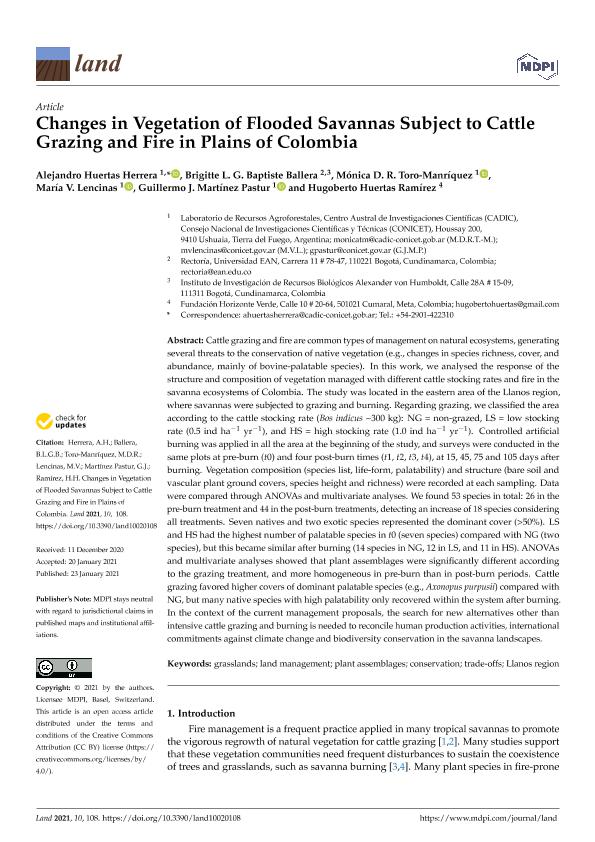Mostrar el registro sencillo del ítem
dc.contributor.author
Huertas Herrera, Alejandro

dc.contributor.author
Baptiste Ballera, Brigitte L.G.
dc.contributor.author
Toro Manríquez, Mónica del Rosario

dc.contributor.author
Lencinas, María Vanessa

dc.contributor.author
Martínez Pastur, Guillermo José

dc.contributor.author
Huerta Ramírez, Hugoberto
dc.date.available
2021-10-01T17:51:24Z
dc.date.issued
2021-01
dc.identifier.citation
Huertas Herrera, Alejandro; Baptiste Ballera, Brigitte L.G.; Toro Manríquez, Mónica del Rosario; Lencinas, María Vanessa; Martínez Pastur, Guillermo José; et al.; Changes in vegetation of flooded savannas subject to cattle grazing and fire in plains of Colombia; Molecular Diversity Preservation International; Land; 10; 2; 1-2021; 1-14
dc.identifier.issn
2073-445X
dc.identifier.uri
http://hdl.handle.net/11336/142272
dc.description.abstract
Cattle grazing and fire are common types of management on natural ecosystems, generating several threats to the conservation of native vegetation (e.g., changes in species richness, cover, and abundance, mainly of bovine-palatable species). In this work, we analysed the response of the structure and composition of vegetation managed with different cattle stocking rates and fire in the savanna ecosystems of Colombia. The study was located in the eastern area of the Llanos region, where savannas were subjected to grazing and burning. Regarding grazing, we classified the area according to the cattle stocking rate (Bos indicus ~300 kg): NG = non-grazed, LS = low stocking rate (0.5 ind ha-1 yr-1), and HS = high stocking rate (1.0 ind ha-1 yr-1). Controlled artificial burning was applied in all the area at the beginning of the study, and surveys were conducted in the same plots at pre-burn (t0) and four post-burn times (t1, t2, t3, t4), at 15, 45, 75 and 105 days after burning. Vegetation composition (species list, life-form, palatability) and structure (bare soil and vascular plant ground covers, species height and richness) were recorded at each sampling. Data were compared through ANOVAs and multivariate analyses. We found 53 species in total: 26 in the pre-burn treatment and 44 in the post-burn treatments, detecting an increase of 18 species considering all treatments. Seven natives and two exotic species represented the dominant cover (>50%). LS and HS had the highest number of palatable species in t0 (seven species) compared with NG (two species), but this became similar after burning (14 species in NG, 12 in LS, and 11 in HS). ANOVAs and multivariate analyses showed that plant assemblages were significantly different according to the grazing treatment, and more homogeneous in pre-burn than in post-burn periods. Cattle grazing favored higher covers of dominant palatable species (e.g., Axonopus purpusii) compared with NG, but many native species with high palatability only recovered within the system after burning. In the context of the current management proposals, the search for new alternatives other than intensive cattle grazing and burning is needed to reconcile human production activities, international commitments against climate change and biodiversity conservation in the savanna landscapes.
dc.format
application/pdf
dc.language.iso
eng
dc.publisher
Molecular Diversity Preservation International

dc.rights
info:eu-repo/semantics/openAccess
dc.rights.uri
https://creativecommons.org/licenses/by-nc-sa/2.5/ar/
dc.subject
CONSERVATION
dc.subject
GRASSLANDS
dc.subject
LAND MANAGEMENT
dc.subject
LLANOS REGION
dc.subject
PLANT ASSEMBLAGES
dc.subject
TRADE-OFFS
dc.subject.classification
Otras Agricultura, Silvicultura y Pesca

dc.subject.classification
Agricultura, Silvicultura y Pesca

dc.subject.classification
CIENCIAS AGRÍCOLAS

dc.title
Changes in vegetation of flooded savannas subject to cattle grazing and fire in plains of Colombia
dc.type
info:eu-repo/semantics/article
dc.type
info:ar-repo/semantics/artículo
dc.type
info:eu-repo/semantics/publishedVersion
dc.date.updated
2021-08-13T16:20:18Z
dc.journal.volume
10
dc.journal.number
2
dc.journal.pagination
1-14
dc.journal.pais
Suiza

dc.description.fil
Fil: Huertas Herrera, Alejandro. Consejo Nacional de Investigaciones Científicas y Técnicas; Argentina
dc.description.fil
Fil: Baptiste Ballera, Brigitte L.G.. Instituto de Investigación de Recursos Biológicos Alexander von Humboldt; Colombia
dc.description.fil
Fil: Toro Manríquez, Mónica del Rosario. Consejo Nacional de Investigaciones Científicas y Técnicas. Centro Austral de Investigaciones Científicas; Argentina
dc.description.fil
Fil: Lencinas, María Vanessa. Consejo Nacional de Investigaciones Científicas y Técnicas. Centro Austral de Investigaciones Científicas; Argentina
dc.description.fil
Fil: Martínez Pastur, Guillermo José. Consejo Nacional de Investigaciones Científicas y Técnicas. Centro Austral de Investigaciones Científicas; Argentina
dc.description.fil
Fil: Huerta Ramírez, Hugoberto. Fundación Horizonte Verde; Colombia
dc.journal.title
Land
dc.relation.alternativeid
info:eu-repo/semantics/altIdentifier/url/https://www.mdpi.com/2073-445X/10/2/108
dc.relation.alternativeid
info:eu-repo/semantics/altIdentifier/doi/https://doi.org/10.3390/land10020108
Archivos asociados
